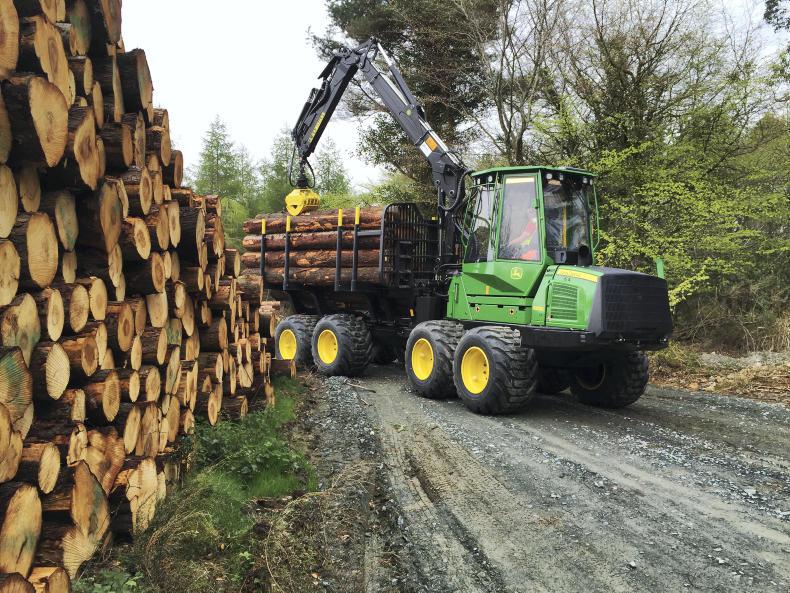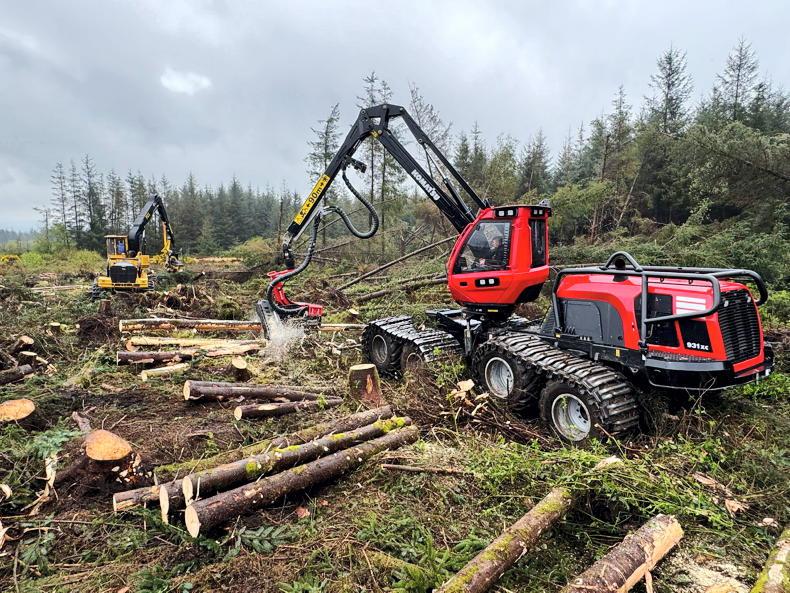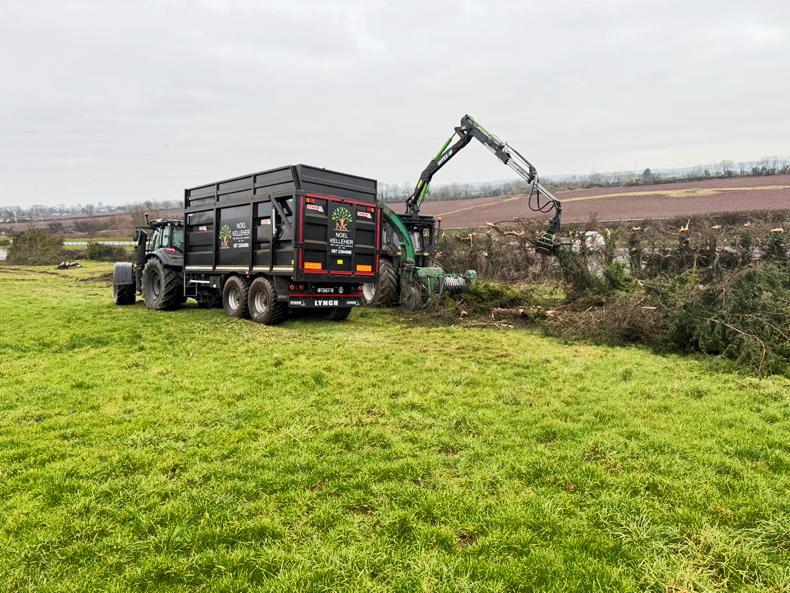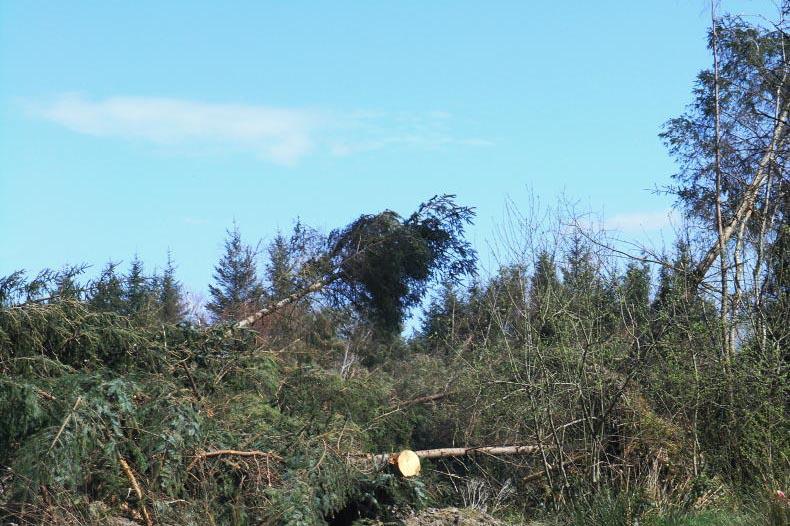Coillte timber prices are based on the company’s own sales, while private sale prices are compiled by University College Dublin for the ITGA. Both sets of data are also made available to the Irish Farmers Journal.
However, timber is sold by weight (t) rather than volume (m3) in Ireland, so a Sitka spruce commercial sale of 1,000m3 valued at €60/m3 is worth €67/t at a volume/weight conversion factor of 1.12.
The accurate measurement of timber and security of log movement are two key issues during forest harvesting and sale. From the time a sale is agreed to final payment, there are a number of elements whereby the seller can ensure that all timber removed reaches its correct place of destination and that the price achieved is fair for both seller and buyer.
These safeguard against the illegal removal of logs from forests and incorrect payment – or non-payment – for logs removed.
A formal contract with the purchaser is an essential step between seller and buyer, but before this takes place the forest owner should have sufficient information about the quality and the volume of the timber in the crop. This requires an inventory or pre-sale measurement.
A forest owner or forester managing the sale can measure the volume of a crop by taking a number of sample plots and calculating the volume to be removed based on the area of forest and average tree size. Once the volume is measured, an estimate of the likely price can be achieved based on the breakdown or assortment sizes, usually comprising pulpwood (small logs), stake wood (small to medium logs), pallet wood (also light commercial or boxwood) and sawlog (large logs for construction).
At this stage the forester managing the sale should approach at least three potential customers. Contracts are drawn up to ensure that harvesting is carried out properly and that the forest owner is paid for the volume of timber removed by the successful purchaser. This contract is between the seller and buyer, but also involves the harvesting contractor and the haulier.
“Have your eyes open and be aware of all elements required when drawing up a contract with the purchaser,” is the advice of one seasoned forester. The template for a successful contact is the master timber sales agreement, which was developed by the ITGA for private forest owners and timber buyers.
This deals with a range of site-specific issues to ensure that the forest is harvested properly. It includes operational procedures, compliance with environmental guidelines and insurance cover. It also covers safety precautions and issues such as damage to owner’s property, gates and fences and who is responsible to ensure corrective action in the event of damage.
A major element of the sales agreement is the sales template, which covers security, payment timing and work schedule. This includes:
Security and accountability in the timber sale, supply of forest dockets, removal conditions, procedures and times permitted for access. Agreement of purchase price, deposit and payment agreement, instalment timing and payment schedule. Commencement and completion dates. Agreement on forest access times, road/track use, timber vehicles and maximum load weights.A key aspect of the sale agreement is the price of delivered logs. As discussed, the standard method of sale is usually based on weight. When a sale is agreed on a weight basis, the forest owner will only get paid for the timber weighed over a weighbridge at the sawmill, pulpmill, or other outlet.
This can be an area of contention, so it’s important that the agreement factors in possible issues that can cause problems. For example, timber should be removed from the site, ideally within two weeks of felling.
It is important to remove logs from the site as early as possible as timber dries out rapidly especially in summer, so the sales agreement should allow – and compensate – for delayed removal of logs.
It should be remembered that the 1,000m3 of logs already mentioned (converting to 900t) valued at €67/t at a volume/weight conversion of 1.12, will only weigh in at approximately 800t if left on site for a further month, especially during a dry summer as experienced last year. In a commercial clearfell this could reduce the value of 1,000m3 by up to €6,000.
The ITGA template tree sale caters for this eventuality. It states that all roundwood is to be removed from the site within 15 working days of felling. Where delays occur the agreement allows for an increase of 3% for every seven days after the initial 15-day period agreed.
Coillte timber prices are based on the company’s own sales, while private sale prices are compiled by University College Dublin for the ITGA. Both sets of data are also made available to the Irish Farmers Journal.
However, timber is sold by weight (t) rather than volume (m3) in Ireland, so a Sitka spruce commercial sale of 1,000m3 valued at €60/m3 is worth €67/t at a volume/weight conversion factor of 1.12.
The accurate measurement of timber and security of log movement are two key issues during forest harvesting and sale. From the time a sale is agreed to final payment, there are a number of elements whereby the seller can ensure that all timber removed reaches its correct place of destination and that the price achieved is fair for both seller and buyer.
These safeguard against the illegal removal of logs from forests and incorrect payment – or non-payment – for logs removed.
A formal contract with the purchaser is an essential step between seller and buyer, but before this takes place the forest owner should have sufficient information about the quality and the volume of the timber in the crop. This requires an inventory or pre-sale measurement.
A forest owner or forester managing the sale can measure the volume of a crop by taking a number of sample plots and calculating the volume to be removed based on the area of forest and average tree size. Once the volume is measured, an estimate of the likely price can be achieved based on the breakdown or assortment sizes, usually comprising pulpwood (small logs), stake wood (small to medium logs), pallet wood (also light commercial or boxwood) and sawlog (large logs for construction).
At this stage the forester managing the sale should approach at least three potential customers. Contracts are drawn up to ensure that harvesting is carried out properly and that the forest owner is paid for the volume of timber removed by the successful purchaser. This contract is between the seller and buyer, but also involves the harvesting contractor and the haulier.
“Have your eyes open and be aware of all elements required when drawing up a contract with the purchaser,” is the advice of one seasoned forester. The template for a successful contact is the master timber sales agreement, which was developed by the ITGA for private forest owners and timber buyers.
This deals with a range of site-specific issues to ensure that the forest is harvested properly. It includes operational procedures, compliance with environmental guidelines and insurance cover. It also covers safety precautions and issues such as damage to owner’s property, gates and fences and who is responsible to ensure corrective action in the event of damage.
A major element of the sales agreement is the sales template, which covers security, payment timing and work schedule. This includes:
Security and accountability in the timber sale, supply of forest dockets, removal conditions, procedures and times permitted for access. Agreement of purchase price, deposit and payment agreement, instalment timing and payment schedule. Commencement and completion dates. Agreement on forest access times, road/track use, timber vehicles and maximum load weights.A key aspect of the sale agreement is the price of delivered logs. As discussed, the standard method of sale is usually based on weight. When a sale is agreed on a weight basis, the forest owner will only get paid for the timber weighed over a weighbridge at the sawmill, pulpmill, or other outlet.
This can be an area of contention, so it’s important that the agreement factors in possible issues that can cause problems. For example, timber should be removed from the site, ideally within two weeks of felling.
It is important to remove logs from the site as early as possible as timber dries out rapidly especially in summer, so the sales agreement should allow – and compensate – for delayed removal of logs.
It should be remembered that the 1,000m3 of logs already mentioned (converting to 900t) valued at €67/t at a volume/weight conversion of 1.12, will only weigh in at approximately 800t if left on site for a further month, especially during a dry summer as experienced last year. In a commercial clearfell this could reduce the value of 1,000m3 by up to €6,000.
The ITGA template tree sale caters for this eventuality. It states that all roundwood is to be removed from the site within 15 working days of felling. Where delays occur the agreement allows for an increase of 3% for every seven days after the initial 15-day period agreed.










SHARING OPTIONS